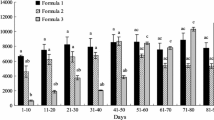Abstract
The fecundity of the blood-feeding insect,Rhodnius prolixus, was observed to increase in successive periods of egg production, each period being triggered by a single large blood meal. As previously published, the fecundity of mated animals was significantly higher than that of unmated animals for the first period of egg production. For a second period of egg production, fecundity increased significantly in both mated and unmated animals. By the fourth period, fecundity had returned to first-feed values for mated animals, but remained high for unmated animals, and the fecundity of mated and unmated animals was not significantly different. Thus, during successive periods of egg production, the processes which maintain fecundity of unmated animals below that of mated animals are overcome.
Similar content being viewed by others
References
Friend, W. G., Choy, C. T. H., and Cartwright, E., Can. J. Zool.43 (1965) 891.
Lima Gomes, J. E. P., Azambuja, P., and Garcia, E. S., Mem. Inst. Oswaldo Cruz85 (1990) 299.
Davey, K. G., in: Endocrinology of Insects, p. 251. Eds R. G. H. Downer and H. Laufer. Alan R. Liss Inc., New York 1983.
Buxton, P., Trans. ent. Soc. London78 (1930) 227.
Davey, K. G., and Singleton, D. M., Invert Reprod. Dev.16 (1989) 131.
Ruegg, R. P., and Davey, K. G., Int. J. Invert. Reprod.1 (1979) 3.
Chiang, R. G., and Davey, K. G., Invert. Reprod. Dev.18 (1990) 177.
Davey, K. G., J. Insect Physiol.16 (1967) 1629.
Patterson, J. W., J. Insect Physiol.25 (1979) 311.
Davey, K. G., and Kriger, F. G., Gen. comp. Endocr.58 (1985) 452.
Davey, K. G., Maimets, I.-K., and Ruegg, R. P., Can. J. Zool.64 (1986) 2654.
Adams, T. S., and Gerst, J. W., J. Insect Physiol.39 (1993) 835.
Uchida, K., J. Insect Physiol.39 (1993) 615.
Valle, D., Lima Gomes, J. E. P., Goldenberg, S., and Garcia, E. S., J. Insect Physiol.33 (1987) 249.
Valle, D., Garcia, E. S., and Goldenberg, S., Insect Biochem. molec. Biol.22 (1992) 159.
Davey, K. G., Archs Insect Biochem. Physiol.4 (1987) 243.
Shirk, P. D., Bhaskaran, G., and Roller, H. Experientia36 (1980) 682.
Sasaki, M., and Riddiford, L., Physiol. Ent.9 (1984) 315.
Stringer, I. A. N., Giebultowicz, J. M., and Riddiford, L., J. Invert. Reprod.8 (1985) 83.
Author information
Authors and Affiliations
Rights and permissions
About this article
Cite this article
Chiang, R.G., Chiang, J.A. Fecundity of the blood-feeding insectRhodnius prolixus increases in successive periods of egg production. Experientia 51, 289–292 (1995). https://doi.org/10.1007/BF01931114
Received:
Accepted:
Published:
Issue Date:
DOI: https://doi.org/10.1007/BF01931114




